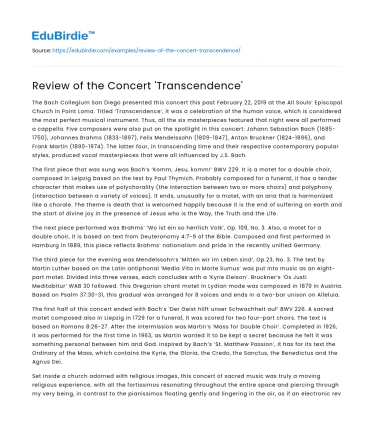The Bach Collegium San Diego presented this concert this past February 22, 2019 at the All Souls’ Episcopal Church in Point Loma. Titled ‘Transcendence’, it was a celebration of the human voice, which is considered the most perfect musical instrument. Thus, all the six masterpieces featured that night were all performed a cappella. Five composers were also put on the spotlight in this concert: Johann Sebastian Bach (1685-1750), Johannes Brahms (1833-1897), Felix Mendelssohn (1809-1847), Anton Bruckner (1824-1896), and Frank Martin (1890-1974). The latter four, in transcending time and their respective contemporary popular styles, produced vocal masterpieces that were all influenced by J.S. Bach.
The first piece that was sung was Bach’s ‘Komm, Jesu, komm!’ BWV 229. It is a motet for a double choir, composed in Leipzig based on the text by Paul Thymich. Probably composed for a funeral, it has a tender character that makes use of polychorality (the interaction between two or more choirs) and polyphony (interaction between a variety of voices). It ends, unusually for a motet, with an aria that is harmonized like a chorale. The theme is death that is welcomed happily because it is the end of suffering on earth and the start of divine joy in the presence of Jesus who is the Way, the Truth and the Life.
Save your time!
We can take care of your essay
- Proper editing and formatting
- Free revision, title page, and bibliography
- Flexible prices and money-back guarantee
The next piece performed was Brahms’ ‘Wo ist ein so herrlich Volk’, Op. 109, No. 3. Also, a motet for a double choir, it is based on text from Deuteronomy 4:7-9 of the Bible. Composed and first performed in Hamburg in 1889, this piece reflects Brahms’ nationalism and pride in the recently unified Germany.
The third piece for the evening was Mendelssohn’s ‘Mitten wir im Leben sind’, Op.23, No. 3. The text by Martin Luther based on the Latin antiphonal ‘Media Vita in Morte Sumus’ was put into music as an eight-part motet. Divided into three verses, each concludes with a ‘Kyrie Eleison’. Bruckner’s ‘Os Justi Meditabitur’ WAB 30 followed. This Gregorian chant motet in Lydian mode was composed in 1879 in Austria. Based on Psalm 37:30-31, this gradual was arranged for 8 voices and ends in a two-bar unison on Alleluia.
The first half of this concert ended with Bach’s ‘Der Geist hilft unser Schwachheit auf’ BWV 226. A sacred motet composed also in Liepzig in 1729 for a funeral, it was scored for two four-part choirs. The text is based on Romans 8:26-27. After the intermission was Martin’s ‘Mass for Double Choir’. Completed in 1926, it was performed for the first time in 1963, as Martin wanted it to be kept a secret because he felt it was something personal between him and God. Inspired by Bach’s ‘St. Matthew Passion’, it has for its text the Ordinary of the Mass, which contains the Kyrie, the Gloria, the Credo, the Sanctus, the Benedictus and the Agnus Dei.
Set inside a church adorned with religious images, this concert of sacred music was truly a moving religious experience, with all the fortissimos resonating throughout the entire space and piercing through my very being, in contrast to the pianissimos floating gently and lingering in the air, as if an electronic reverb was being employed. However, what made this concert connect with me the most is the participation of eight fellow SDSU Music students whom I personally know. Having experienced what great singers these eight are, made me feel as if all the motets featured that night were sung especially and directly to me.






 Stuck on your essay?
Stuck on your essay?

